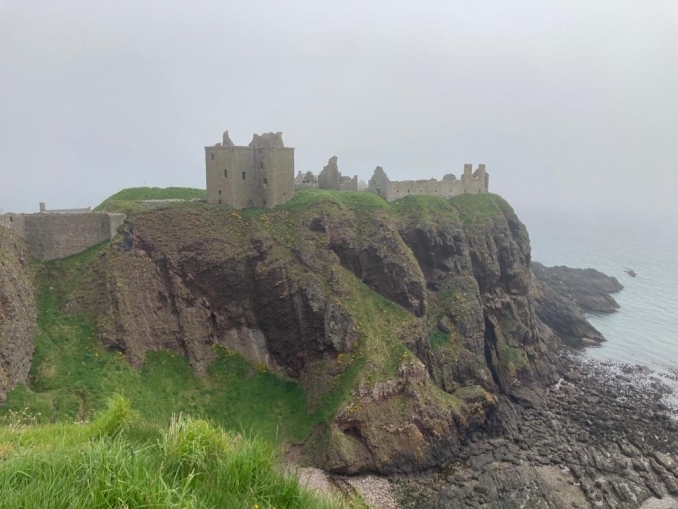Dunnottar Castle - Dùn Fhoithear

Dunnottar Castle (Scottish Gaelic: Dùn Fhoithear) is about two miles south of the town of Stonehaven, Aberdeenshire, Scotland (Scottish Gaelic: Cala na Creige, Siorrachd Obar Dheathain, Alba). This castle consists of eleven buildings built from the early thirteenth century. The keep is fourteenth century and other buildings added up until the seventeenth century. The ruined castle sits on the cliff top in a spectacular location south along the Coastal Path from Stonehaven Harbour. It can also be accessed via the A92 and a footpath from a nearby car park and is open daily throughout the year.
Over its long history it has been the site of many sieges and battles. Not least in the battles Scotland has had with its ancient foe the English. The history of the castle has been described as encapsulating the history of Scotland in miniature. Amongst the many events it has experienced has been the taking back of the castle from the English in 1297 by Scottish hero William Wallace. Dunnottar Castle also protected the Honours of Scotland (The Scottish Crown Jewels) from Oliver Cromwell who laid siege to the fortress for eight months in 1651-52. The castle finally fell into ruin after Earl Marischal William Keith had his estates confiscated after supporting the the Jacobite rising of 1715. The buildings that can be seen today mostly date to the 15th and 16th centuries and restoration work was undertaken in the 20th century.
The castle is surrounded by steep cliffs and is about 160 feet above the North Sea with only a narrow strip of land giving access to the site. The ruins of the castle are spread over 1.4 hectares (3+1⁄2 acres). Included amongst the various buildings within the castle are the 14th-century tower house as well as the 16th-century palace. Their have been previous buildings on the site of the castle. Although it is not known when the first fortification was built on the headland, evidence of Picts living on the sea stack of Dunnicaer, just north of the castle, has been found by a team of archaeologists from the University of Aberdeen. Carbon dating shows this to be the oldest Pictish fort ever discovered dating to the 3rd century AD. In the 4th century Saint Ninian, an early missionary among the Pictish peoples of what is now Scotland, built a place of worship at Dunnottar. There are also written references in the Annals of Ulster (Irish: Annála Uladh) that record two sieges of "Dún Foither" in 681 and 694.
Links: Dunnottar Castle website and also Visit Scotland.
Celtic nation:
- Scotland
Itinerary:
- Scotland Grampian
Place type:
- Castle





